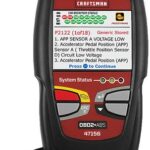For car owners and auto enthusiasts familiar with vehicle diagnostics, the OBD2 (On-Board Diagnostics II) port is a standard interface. It’s the gateway to accessing a wealth of data about your car’s health and performance. But when it comes to Tesla, things are a little different. A common question arises: Does Tesla Use Obd2? The short answer is yes, but with a Tesla twist. Let’s delve into how Tesla handles vehicle diagnostics and what you need to know to access your Tesla’s data.
While Tesla vehicles, including the popular Model 3 and Model Y, do technically incorporate OBD2 protocols, they do not feature the standard OBD2 port you’d find in most gasoline or diesel cars. Instead of the readily accessible port under the dashboard, Tesla uses a console connector located in the rear passenger area of the vehicle. This means that to utilize standard OBD2 tools with your Tesla, you’ll need a Tesla OBD2 adapter cable.
This adapter serves as a bridge, converting Tesla’s proprietary connector to the universal OBD2 interface. Once you have the adapter, you can connect an ELM327 or STN1110 compatible OBD2 device. Popular choices among Tesla owners include OBDLink LX or MX Bluetooth devices, known for their reliability and compatibility with diagnostic apps. Using the correct adapter and a compatible OBD2 tool opens up the door to viewing a range of live data from your Tesla.
However, it’s important to understand the limitations. Tesla’s advanced security systems are designed to protect the vehicle’s critical functions from unauthorized access or modification. Therefore, connecting through the OBD2 port, even with an adapter, primarily grants you read-only access to vehicle data. You won’t be able to make changes to the car’s software or control its core functionalities. The primary purpose of this access is to monitor live vehicle statistics using specialized diagnostic applications.
Two prominent apps have emerged as favorites among Tesla owners for viewing this live data: Scan My Tesla and TM-Spy. These apps, available for both Android and iOS, leverage the OBD2 connection to display a wealth of information in real-time.
Scan My Tesla provides users with a comprehensive view of key vehicle metrics, including:
- Battery health: power, voltage, current, and temperatures
- Drive Unit performance: electric power, torque, horsepower, RPM, and temperatures
- Battery lifespan statistics, capacity estimations, and mileage
- 12V system monitoring: current, voltage, and temperature
- Trip recording and statistics, including charging data
- HVAC system controls and readings
[Refer to the original article for Bjørn Nyland’s video if embedding is possible, otherwise, consider a text link with context]
Similarly, TM-Spy offers detailed insights, with a particular focus on battery cell-level data:
- Individual Cell voltages (for detailed battery health analysis)
- Maximum, minimum cell voltages, and the voltage difference (delta) for battery balancing assessment
- Battery pack temperature sensor readings across multiple points
- Total battery voltage and current during driving and charging
- Pack capacity and remaining energy in kWh
- Mileage tracking specific to the current battery pack
- Lifetime battery charge and discharge energy consumption
[Refer to the original article for David Drives Electric’s video if embedding is possible, otherwise, consider a text link with context]
The development of these valuable diagnostic tools and the understanding of Tesla’s data interface is largely thanks to the dedicated Tesla community. Through meticulous research and collaboration, they’ve identified and documented the CAN bus IDs and data points within Tesla vehicles, making this wealth of information accessible to owners. Resources like the community-driven Google Sheets document and forums such as Tesla Owners Online are invaluable for those wanting to delve deeper into Tesla diagnostics.
In conclusion, while Tesla deviates from the standard OBD2 port location, it does utilize OBD2 protocols for diagnostics. To access this data, you’ll need a Tesla OBD2 adapter and a compatible OBD2 tool, along with apps like Scan My Tesla or TM-Spy. This setup allows Tesla owners to monitor their vehicle’s performance and health, providing a deeper understanding of their electric vehicle, all thanks to the efforts of the Tesla community.
